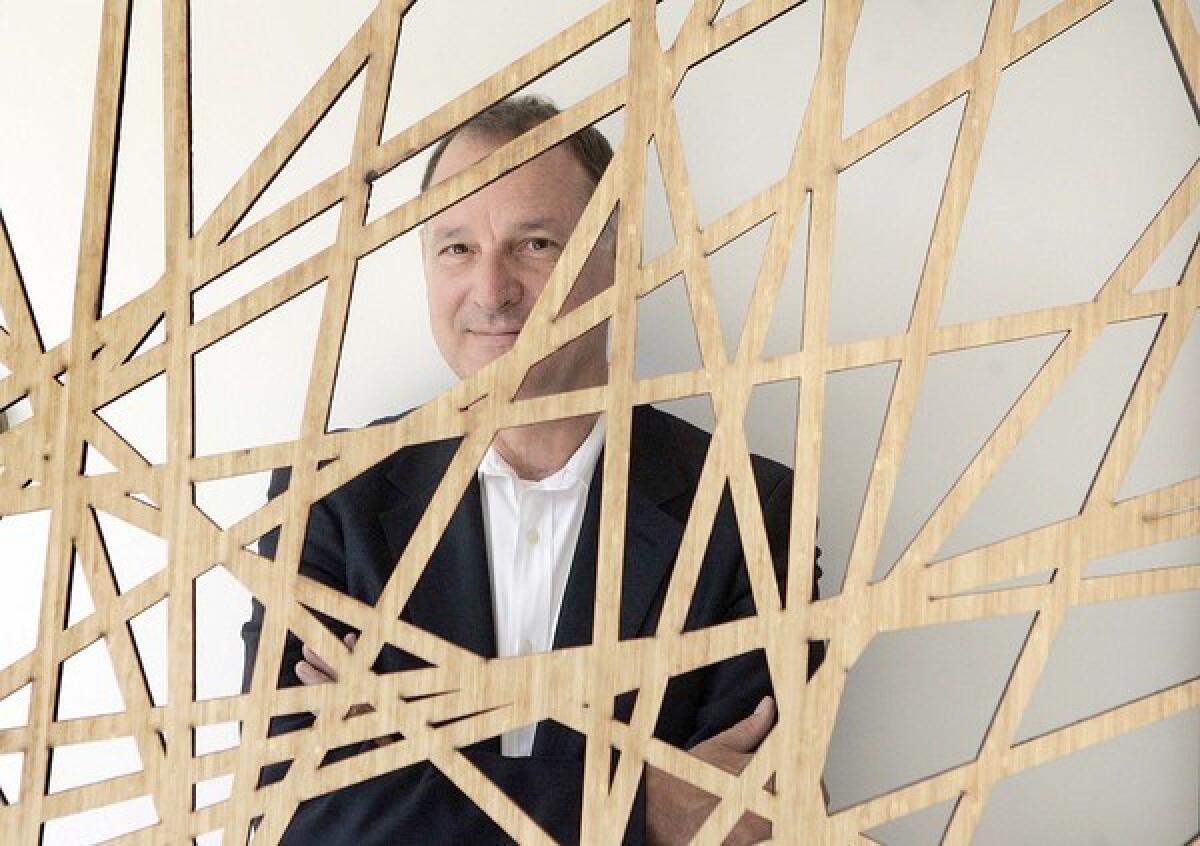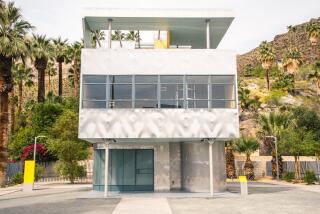Frederick Fisher’s radical vision

The Los Angeles architect Frederick Fisher, who turned 60 earlier this year, is anything but a doctrinaire designer or a dogmatic personality. His houses, museum galleries and other buildings have over the years been executed in a relatively broad stylistic range, reflecting his curiosity, his interest in context and place and the diverse tastes of his well-connected clients. On the website of his firm, Frederick Fisher and Partners, you’ll find curtain walls as well as gables, mahogany a few clicks away from corrugated metal.
Still, many of Fisher’s most recent public and institutional projects -- including the Annenberg Community Beach House at Santa Monica State Beach, which just wrapped up a wildly successful first summer in operation, and a new academic building at Caltech that will be officially dedicated Friday -- share many of the hallmarks of modern architecture: the clean lines, the boxy, glass-wrapped volumes, the disdain for literal historical ornament. They also show a decided interest in Minimalism, paying as much attention to the spaces between buildings as to the buildings themselves.
It is not simply the precision of their forms, though, that makes these projects significant or that marks them as a turning point for Fisher, who works out of A. Quincy Jones’ old offices on Santa Monica Boulevard, a few blocks west of the 405. It is what those forms frame, acknowledge and make room for.
Modern architecture, as even the most casual design fan knows, has a long and significant history in Southern California. What it hasn’t been known for is a significant, or respectful, interest in history. Sure, there have always been strong connections between Modernism and the rigor of classical design. But in general, a flat-roofed International Style building in Los Angeles was meant to represent the future -- a clean, often polemical break with the past that could also signal innovation and optimism.
Fisher’s recent projects, by contrast, employ restraint not in an effort to wipe the historical slate clean but as framing devices to set off and help us examine the past, the surrounding architectural context and, perhaps most significant, the always-slippery and typically fraught relationship between public and private space.
The Beach House is a remarkable case in point, a highly significant design hiding under unassuming cover. It occupies the site of a sprawling 5-acre seaside estate William Randolph Hearst built for his mistress, Marion Davies, in the 1920s and early 1930s. The property was crowned by a 110-room Georgian Revival mansion designed by William Edward Flannery for Davies and a separate guest house, by Julia Morgan, to the north.
After the main house fell into disrepair -- it was eventually demolished -- the property languished. Every new proposal to develop the site -- including a quite sizable hotel -- was drawn into the maw of Santa Monica politics. Finally the city, with cooperation from the state and a significant donation from the Annenberg Foundation, committed itself to restoring the guest house and original pool and constructing a new pool house and community center, along with ancillary buildings, where the Flannery mansion once stood. The total construction costs were roughly $30 million.
Working in concrete, cement board, wood and glass -- straightforward materials -- Fisher created a crisp, colorful ensemble that celebrates the site’s new public role while solidly marking its past. The most direct reference to the Hearst-Davies legacy is a series of 14 concrete pillars, each 30 feet high, that run between the pool and the new locker room and recall the stately ionic columns that once decorated the front of the mansion. Stripped of fluting and ornament, the pillars also operate abstractly, giving a sense of rhythm to the relationship between the new and old architectural pieces.
The process of getting the beach club approved, designed, built and opened could hardly have been more complicated. Local residents succeeded in forcing the city to significantly limit its hours of operation. (The facilities are open daily during the summer months and available for rent for private events year-round.) Volleyball players, lap swimmers and preservationists were just few of the interest groups that weighed in on the architecture. Still, it is now possible for anyone, for free, to make a reservation to swim in Marion Davies’ pool on the edge of the beach or stand on a corridor outside the community room upstairs and enjoy the same view Hearst did of the Pacific.
At Caltech, meanwhile, Fisher’s Annenberg Center for Information Science and Technology faced a different set of constraints, including the challenge of surviving Pasadena’s notorious design-review process and taking its place in a campus that is filled with historic buildings -- including work by Bertram Goodhue and Gordon Kaufmann -- as well as ones that do their best to match the older architecture. The project was originally given to Rem Koolhaas and his Office for Metropolitan Architecture and only later wound up with Fisher’s firm.
The resulting building -- underwritten like the Beach House by the Annenberg Foundation, for which Fisher is also designing a new visitor center adjacent to the Sunnylands Estate in Rancho Mirage -- is a glass box, covering three floors and 46,000 square feet and wrapped in vertical panels tinted various shades of green. The color signals the project’s interest in sustainability but also suggests that a design as contemporary as this one, on this campus, is well served by at least a bit of camouflage. If the building is marked by any missteps, they come when Fisher moves away from the composure and proportion of precise forms and toward more decorative elements, such as the busy hanging screen that covers one side of the atrium inside.
The Modernist
If Fisher’s current work makes him look like a Modernist, he is one, importantly, who came of age after the end of Modernism in the 1960s and lived through and learned from all that followed: the historically minded but sometimes flimsy Postmodern movement, the rough edges and hard attitudes of the L.A. School, the tortured facades of Deconstructivism.
Fisher, who grew up in Cleveland, studied at Oberlin and UCLA and worked early in his career for Frank Gehry, cites no bigger single influence on his philosophical approach than architect Robert Venturi, who in the 1960s and 1970s helped coax the profession back in the direction of history and ambiguity. Fisher’s second residential design, the Jorgenson House in Hollywood, was inspired by ruins, and he was a fellow last year at the American Academy in Rome, which allowed him more time to engage his interest in the architectural and urban past. As a result, he now treats complexity, uncertainty, the ghosts of history -- all those Postmodern tropes -- not as the basis for form-making but as forces that contemporary architecture needs to acknowledge and provide a platform for.
In that sense he has positioned himself on the far edge of an architectural divide that has cleaved his generation. On one side are architects like Thom Mayne and Wolf Prix, who twist, tear or fold the skins of their buildings, often to hugely impressive effect, to suggest the complexities and tensions of contemporary society. On the other are architects like Fisher, who have adopted a quieter approach but nonetheless deal head-on with a wide range of social and political constraints. For them, architecture has a role to play in resolving -- not just advertising or dramatizing -- the complexities of 21st century culture.
To understand how the approaches differ, compare Prix’s new high school for the arts on Grand Avenue, which opened last month, to Fisher’s Beach House. The high school is a marvel of enigmatic shape-making but is largely tone-deaf politically. While Prix was focused on making the forms and volumes of the campus as thrillingly complicated as possible, the ambitious educational mission of the school, caught up in the very real complexity of the Los Angeles Unified School District, ethnic issues, and the patronage of Eli Broad, was steadily being compromised.
At the Beach House, on the other hand, Fisher kept his eye fixed from the beginning on the project’s extra-architectural goals: turning what had been a symbol of private wealth and privilege into a public amenity. The design has its own presence and backbone, but it is also willing to operate as a stage for conjuring and confronting the past. It is Los Angeles architecture’s version of the mnemonic device.
christopher.hawthorne @latimes.com
More to Read
The biggest entertainment stories
Get our big stories about Hollywood, film, television, music, arts, culture and more right in your inbox as soon as they publish.
You may occasionally receive promotional content from the Los Angeles Times.











